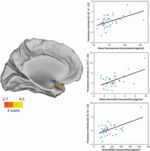The relationship between puberty and social emotion processing
- PMID: 23106734
- PMCID: PMC3795450
- DOI: 10.1111/j.1467-7687.2012.01174.x
The relationship between puberty and social emotion processing
Abstract
The social brain undergoes developmental change during adolescence, and pubertal hormones are hypothesized to contribute to this development. We used fMRI to explore how pubertal indicators (salivary concentrations of testosterone, oestradiol and DHEA; pubertal stage; menarcheal status) relate to brain activity during a social emotion task. Forty-two females aged 11.1 to 13.7 years underwent fMRI scanning while reading scenarios pertaining either to social emotions, which require the representation of another person's mental states, or to basic emotions, which do not. Pubertal stage and menarcheal status were used to assign girls to early or late puberty groups. Across the entire sample, the contrast between social versus basic emotion resulted in activity within the social brain network, including dorsomedial prefrontal cortex (DMPFC), the posterior superior temporal sulcus, and the anterior temporal cortex (ATC) in both hemispheres. Increased hormone levels (independent of age) were associated with higher left ATC activity during social emotion processing. More advanced age (independent of hormone levels) was associated with lower DMPFC activity during social emotion processing. Our results suggest functionally dissociable effects of pubertal hormones and age on the adolescent social brain.
© 2012 Blackwell Publishing Ltd.
Figures



References
-
- Abraham A, Werning M, Rakoczy H, von Cramon DY, Schubotz RI. Minds, persons, and space: an fMRI investigation into the relational complexity of higher-order intentionality. Consciousness and Cognition. 2008;17(2):438–450. doi: 10.1016/j.concog.2008.03.011. - DOI - PubMed
-
- Amodio DM, Frith CD. Meeting of minds: the medial frontal cortex and social cognition. Nature Reviews Neuroscience. 2006;7(4):268–277. doi: 10.1038/nrn1884. - DOI - PubMed
-
- Andersen SL, Thompson AP, Krenzel E, Teicher MH. Pubertal changes in gonadal hormones do not underlie adolescent dopamine receptor overproduction. Psychoneuroendocrinology. 2002;27(6):683–691. doi:16/S0306-4530(01)00069-5. - PubMed
-
- Attwell D, Buchan AM, Charpak S, Lauritzen M, Macvicar BA, Newman EA. Glial and neuronal control of brain blood flow. Nature. 2010;468(7321):232–243. doi: 10.1038/nature09613. - DOI - PMC - PubMed
Publication types
MeSH terms
Substances
Grants and funding
LinkOut - more resources
Full Text Sources
Medical
Research Materials

